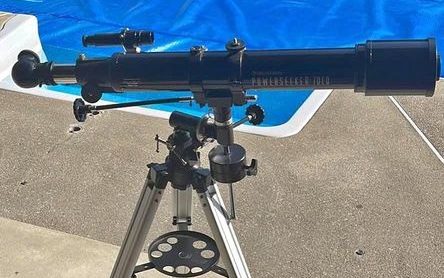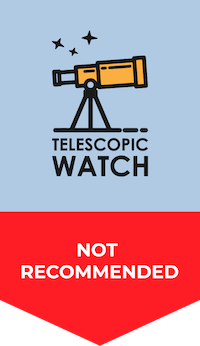The Powerseeker 70mm Optical Tube Overview
The Celestron PowerSeeker 70 EQ is a 70mm f/10 achromatic doublet refractor. The 70mm of aperture with the old 2x per millimetre rule of thumb for maximum magnification means that you can’t use the scope for more than 140x without having a fuzzy, broken-down image—contrary to the outrageous claims of 525x which Celestron says you can achieve (and should supposedly use) with the scope.

At f/10, there is some chromatic aberration, but nothing significant enough to ruin high-power views with this telescope. The optical quality of the Powerseeker 70 is quite good.
The scope’s focuser is a 1.25” rack-and-pinion made mostly of plastic. This is to be expected with a scope in this price range, and it functions just fine. The focuser even includes a tension adjustment knob, should you find the focuser to be too loose or too tight.
The Celestron PowerSeeker 70EQ’s tube attaches to the EQ-1 mount with a pair of hinged, felt-lined tube rings that bolt to the mount saddle. This is more primitive than the Vixen-style dovetail rail system supplied with more expensive telescopes, but it used to be the norm for most instruments and works just fine.
Accessories for the PowerSeeker 70EQ
The accessories of the Celestron PowerSeeker 70EQ are really its main weakness, which is nothing to be surprised by.
The finderscope with all Powerseekers is a 5×24 unit with a stopped-down plastic lens and a simple bracket that makes it impossible to align well. As a result, the finder is nearly useless and makes finding or even aiming the telescope at anything besides the moon extremely frustrating.
Like all decent refracting telescopes, the Celestron PowerSeeker 70 EQ telescope includes a star diagonal which deflects the image by 90 degrees for more comfortable viewing. Conveniently, this diagonal is designed to be ergonomically pleasing for use as a handle. Celestron saw during product testing that people like to grab the diagonal to use this way, and so they designed it with that in mind. Unfortunately, it is a cheap Amici erecting prism unit. While an Amici prism is nice for terrestrial viewing as it makes images correct left-right and up-down, there’s no up or down in space and the design of the prism causes stars and other bright objects to have an annoying, distracting, and bright spike running through them. It also absorbs a fair amount of the light entering it, dimming your view.
The PowerSeeker refractors all include two eyepieces: a 20mm Kellner providing 35x with the 70EQ and a 4mm Ramsden providing 175x. The 20mm Kellner is usable and of decent quality, but 35x is a bit much magnification for low power with a 70mm instrument – a 25mm eyepiece providing 28x or a 32mm providing 22x would be better. The 4mm Ramsden is impossible to see anything through, provides a narrow field of view and fuzzy images, and 175x is too much for the telescope to handle, so it’s basically useless apart from serving as a backup dust cap.
The 3x Barlow lens supplied with the PowerSeekers is an utterly rubbish all-plastic unit that costs Celestron less than £1 to produce, and cannot provide a remotely decent image. It belongs in the garbage.
The EQ-1 Equatorial Mount
While inexpensive, the EQ-1 mount supplied with the Celestron PowerSeeker 70EQ is actually a good match for it. The motions are reasonably smooth, and the mount’s extruded aluminium legs are quite steady with such a lightweight tube. Furthermore, the whole setup is pretty light at about 14 pounds. You can also equip the mount with Celestron’s “Logic Drive” for hands-free, motorised tracking.
Obviously, the little EQ1 is incapable of any deep-sky astrophotography, but that’s to be expected at this price point. If you slapped the Logic Drive on and bought/made an adapter to put just the camera on the mount, however, you could get some decent tracked shots with just a short to medium focal length (<300mm) telephoto lens and moderate exposure times.
The main problems with the EQ-1 are that the motions are quite jerky, getting it polar aligned is difficult, and virtually every part of the mount has a tendency to come loose – be it the clutches or the bolt preventing the whole thing from spinning in azimuth. The tripod leg locks are also plastic with metal inserts, and we have witnessed one collapse and subsequently become permanently damaged on more than one occasion. Additionally, setting up, balancing, and aiming an equatorial mount is generally more complicated for beginners.
Should I buy a used PowerSeeker 70EQ?
Unless it’s extremely cheap, a used Celestron PowerSeeker 70EQ probably isn’t worth the trouble. We’d much rather go with a 4” or 4.5” reflector if one is available.
Aftermarket Accessory Recommendations
Upgrading the PowerSeeker 70EQ is probably not worth the expense and hassle. You’d be better off saving your money for a different, and preferably larger/better, telescope.
What can you see with the Celestron PowerSeeker 70EQ?
The Celestron PowerSeeker 70EQ’s relatively small aperture makes it primarily useful for viewing the moon, planets, and double stars. You’ll have no trouble seeing Jupiter’s moons, cloud belts, and the Great Red Spot. Saturn’s rings and a few moons can also be seen. Venus and Mercury present little beyond their phases, and Mars will be a red dot – perhaps with a few dark regions and an ice cape when it’s close to Earth. Uranus and Neptune, if you can find them at all, are tiny, bluish, star-like dots.
Besides solar system objects, the PowerSeeker 70EQ can show you some of the brighter deep-sky objects such as open star clusters, the Orion Nebula, and the Andromeda Galaxy. But don’t get too excited. Besides open star clusters, most of the deep-sky objects you can see with the 70EQ will present themselves as little more than fuzzy balls or dots, and city light pollution can render them invisible altogether.


